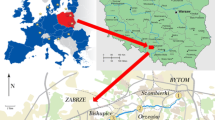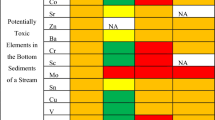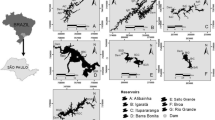Abstract
This study is the first measurement of trace elements in sipunculan and their surrounding sediments. The bioaccumulation characteristics of arsenic (As), cadmium (Cd), chromium (Cr), copper (Cu), mercury (Hg), and zinc (Zn) were analyzed and compared in two sipunculan species, Sipuncula nudus and Siphonosoma vastum, which were collected from seagrass beds and wetlands in Taiwan. The sipunculan and sediment samples were analyzed using an inductively coupled plasma mass spectrometer. Both sipunculan in the wetlands and seagrass beds had a high Cu bioaccumulation mechanism. Multivariate analysis, principle component analysis, and partial least squares for discriminant analysis of trace element levels and bioaccumulation factors were used to distinguish the element distributions that corresponded to the two habitats (seagrass beds and wetlands). Different levels of certain trace elements in these two sipunculan species may result not only from the environmental factors of various habitats but also from the accumulation characteristics of various species. The As, Cd, Cr, Cu, Hg, and Zn concentrations were markedly lower in sipunculan than in other invertebrates from the adjacent polluted regions. The public health issues regarding the consumption of sipunculan are also discussed.








Similar content being viewed by others
References
Amiard, C., Amiard, T., Berthet, B., & Metayer, C. (1987). Comparative study of the patterns of bioaccumulation of essential (Cu, Zn) and non-essential (Cd, Pb) trace metals in various estuarine and coastal organisms. Journal of Experimental Marine Biology and Ecology, 106(1), 73–89.
Apostolaki, E. T., Tatiana, T., Tsapakis, M., & Karakassis, I. (2007). Fish farming impact on sediments and macrofauna associated with seagrass meadows in the Mediterranean. Estuarine, Coastal and Shelf Science, 75(3), 408–416.
Barron, M. G. (1995). Bioaccumulation and concentration in aquatic organisms. In D. J. Hoffman, B. A. Rattner, G. A. Burton Jr., & J. Cairns Jr. (Eds.), Handbook of ecotoxicology (pp. 652–666). Boca Raton: Lewis.
Boening, D. W. (2000). Ecological effects, transport, and fate of mercury: a general review. Chemosphere, 40, 1335–1351.
Chen, Z., & Mayer, L. M. (1998). Digestive proteases of the lugworm (Arenicola marina) inhibited by Cu from contaminated sediments. Environmental Toxicology and Chemistry, 17, 433–438.
Chen, X. X., Chang, Y. L., & Yong, Y. (2009). Effects of Cd and Zn on oxygen consumption and ammonia excretion in sipuncula (Phascolosoma esculenta). Ecotoxicology and Environmental Safety, 72(2), 507–515.
Chien, L. C., Hung, T. C., Choang, K. Y., Yeh, C. Y., Meng, P. J., Shieh, M. J., et al. (2002). Daily intake of TBT, Cu, Zn, Cd and As for fishermen in Taiwan. Science of the Total Environment, 285(1), 177–185.
Coelho-Souza, S. A., Guimaraes, J. R. D., Mauro, J. B. N., Miranda, M. R., & Azevedo, S. M. F. O. (2006). Mercury methylation and bacterial activity associated to tropical phytoplankton. Science of the Total Environment, 364(1), 188–199.
Doong, R. A., Lee, S. H., Lee, C. C., Sun, Y. C., & Wu, S. C. (2008). Characterization and composition of Heavy metals and persistent organic pollutants in water and estuarine sediments from Gao-Ping River, Taiwan. Marine Pollution Bulletin, 57(4), 846–857.
Du Laing, G., Erik, M., Marjan, D., Bart, V., Jörg, R., Filip, M. T., et al. (2009a). Heavy metal mobility in intertidal sediments of the Scheldt estuary: field monitoring. Science of the Total Environment, 407(8), 2919–2930.
Du Laing, G., Rinklebe, J., Vandecasteele, B., Meers, E., & Tack, F. M. G. (2009b). Trace metal behaviour in estuarine and riverine floodplain soils and sediments: a review. Science of the Total Environment, 407(13), 3972–3985.
Fan, W., Wang, W. X., & Chen, J. (2002). Geochemistry of Cd, Cr, and Zn in highly contaminated sediments and its influences on assimilation by marine bivalves. Environmental Science and Technology, 36(23), 5164–5171.
Forstner, U. (1990). Inorganic sediment chemistry and elemental speciation. In R. Baudo, J. Giesy, & H. Muntau (Eds.), Sediments: chemistry and toxicity of in-pace pollutants. (pp. 61–105). Michigan, USA: Lewis Publishers Inc.
Frohne, T., Rinklebe, J., Diaz-Bone, R. A., & Du Laing, G. (2011). Controlled variation of redox conditions in a floodplain soil: impact on metal mobilization and biomethylation of arsenic and antimony. Geoderma, 160, 414–424.
Frohne, T., Rinklebe, J., Langer, U., Du Laing, G., Mothes, S., & Wennrich, R. (2012). Biogeochemical factors affecting mercury methylation rate in two contaminated floodplain soils. Biogeosciences, 9, 493–507.
Han, B. C., & Hung, T. C. (1990). Green oysters caused by copper pollution on the Taiwan coast. Environmental Pollution, 65, 347–362.
Han, B. C., Jeng, W. L., Hung, T. C., & Wen, M. Y. (1996). Relationship between copper speciation in sediments and bioaccumulation by marine bivalves of Taiwan. Environmental Pollution, 91(1), 35–39.
Han, B. C., Jeng, W. L., Hung, T. C., Ling, Y. C., Shieh, M. J., & Chien, L. C. (2000). Estimation of element and organochlorine pesticide exposures and potential health threat by consumption of oysters in Taiwan. Environmental Pollution, 109(1), 147–156.
Hsien, I. T., Acik, S., & Mok, H. K. (2009). Sipunculans associated with the seagrass Thalassia hemprichii from Taiwan and two vicinity Islands. Cahiers de Biologie Marine, 50(2), 171–182.
Hung, T. C., Meng, P. J., Han, B. C., Chuang, A., & Hung, C. C. (2001). Heavy metals in different species of mollusca, water and sediments from Taiwan coastal area. Chemosphere, 44(4), 833–841.
Jeng, M. S., Jeng, W. L., Hung, T. C., Yeh, C. Y., Tseng, R. J., Meng, P. J., et al. (2000). Mussel watch: a review of Cu and other elements in various marine organisms in Taiwan, 1991–1998. Environmental Pollution, 110, 207–215.
Lappalainen, A., Hallfors, G., & Kangas, P. (1977). Littoral benthos of the Northern Baltic Sea. IV. Pattern and dynamics of macrobenthos in a sandy-bottom Zostera marina community in Tvarminne. Internationale Revue der gesamten Hydrobiologie, 62(4), 465–503.
Lee, C. L., Fang, M. D., & Hsieh, M. D. (1998). Characterization and distribution of elements in surficial sediments in southwestern Taiwan. Marine Pollution Bulletin, 36(6), 464–471.
Lin, S., & Hsieh, I. J. (1999). Occurrences of Green Oyster and Heavy metals Contaminant Levels in the Sien-San Area, Taiwan. Marine Pollution Bulletin, 38(11), 960–965.
Ma, H. W., Hung, M. L., & Chen, P. C. (2007). A systemic health risk assessment for the chromium cycle in Taiwan. Environmental International, 33(2), 206–218.
Mazzella, L. & Ott J.A. (1984). Seosonal changes in some features of Posidonia oceanica (L.) Delile leaves and epiphytes at different depths. In C. F. Boudouresque, A. Jeudy de Grissac & J. Olivier (Eds.), International Workshop on Posidonia oceanica beds, GIS Posidonie Publ. France, 1, (pp. 119–127).
Morse, J. W., & Luther, G. W., III. (1999). Chemical influences on trace metal-sulfide interactions in anoxic sediments. Geochimica et Cosmochimica Acta, 63(19/20), 3373–3378.
National Academy of Sciences. (1980). Recommended dietary allowances (9th ed.). Washington: NAS.
Nicole, A. H., Emma, L. J., Catherine, K. K., & Stuart, L. S. (2011). Physico-chemical changes in element-spiked sediments deployed in the field: implications for the interpretation of in situ studies. Chemosphere, 83(4), 400–408.
Peng, S. H., Wang, W. X., Li, X., & Yen, Y. F. (2004). Metal partitioning in river sediments measured by sequential extraction and biomimetic approaches. Chemosphere, 57(8), 839–851.
Shih, R. C., Chen, S. S., Chang, M. H., Chiu, Y. C., Chen, Y. R., Cheng, C. C., et al. (2006). Analysis and investigation of Heavy metals in shellfishes by GFAAS/FLAAS in Taiwan. Annual Scientific Report of National Laboratories of Foods and Drugs, Department of Health, 24, 325–344.
Tiawan, (2001). The estimation of daily intake by Taiwanese, Pesticide Residue Division, Taiwan Agricultural Chemicals and Toxic Substances Research Institutes. (in Chinese)
WHO. (1987). Principles for the safety assessment of food additives and contaminants in food. Environmental Health Criteria. No. 70. Geneva: WHO.
WHO, (1989). Evaluation of certain food additives and contaminants. Thirty-third report of the joint FAO/WHO expert committee on food additives. WHO technical series, No. 807. Geneva, Switzerland.
WHO. (1996). Trace elements in human nutrition and health. Geneva: World Health Organization.
Wu, H., Ding, Z., Liu, Y., Liu, J., Yan, H., Pan, J., et al. (2011). Methylmercury and sulfate-reducing bacteria in mangrove sediments from Jiulong River Estuary, China. Journal of Environmental Science, 23, 14–21.
Yan, Q. L., & Wang, W. X. (2002). Metal Exposure and bioavailability to a marine deposit-feeding spipuncula, Sipunculus nudus. Environmental Science and Technology, 36(1), 40–47.
Zhong, H. H., & Wang, W. X. (2006). Metal–solid interactions controlling the bioavailability of mercury from sediments to clams and sipunculans. Environmental Science and Technology, 40(12), 3794–3799.
Acknowledgments
This research was supported financially by Asia-Pacific Ocean Research Center, National Sun Yat-sen University, funded by the Ministry of Education (R.O.C.) under the grant Aim for the Top University Plan.
Author information
Authors and Affiliations
Corresponding author
Rights and permissions
About this article
Cite this article
Hsieh, IT., Mok, HK., Ko, FC. et al. Environmental assessment of trace element bioaccumulation in sipunculan from seagrass and wetland sediments. Environ Monit Assess 185, 2269–2279 (2013). https://doi.org/10.1007/s10661-012-2707-9
Received:
Accepted:
Published:
Issue Date:
DOI: https://doi.org/10.1007/s10661-012-2707-9




